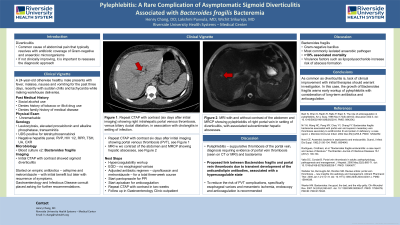Sunday Poster Session
Category: Colon
P0297 - Pylephlebitis: A Rare Complication of Asymptomatic Sigmoid Diverticulitis Associated with Bacteroides Fragilis Bacteremia
Sunday, October 22, 2023
3:30 PM - 7:00 PM PT
Location: Exhibit Hall

Has Audio
- HC
Henry Chang, DO
Riverside University Health Systems-Medical Center
Moreno Valley, California
Presenting Author(s)
Henry Chang, DO1, Lakshmi Puvvula, MD1, Wichit Srikureja, MD2
1Riverside University Health Systems-Medical Center, Moreno Valley, CA; 2Riverside University Health System, Moreno Valley, CA
Introduction: Pylephlebitis is a rare complication of intra-abdominal or pelvic infection. Asymptomatic diverticulitis usually requires no treatment and resolves spontaneously. It is rare for asymptomatic diverticulitis to present with pylephlebitis.
Case Description/Methods: A 24-year-old healthy male presented with fever, chills, malaise, nausea and vomiting for three days without abdominal pain. Examination revealed tachycardia with minimal abdominal tenderness on palpation.
Laboratory tests showed leukocytosis, elevated procalcitonin, alkaline phosphatase, and transaminases. Urinalysis and chest radiograph were normal. Computed tomography (CT) of the abdomen and pelvis with contrast showed sigmoid colon wall thickening consistent with diverticulitis. Blood cultures were drawn. Patient was admitted and started on intravenous cefepime and metronidazole.
However, he continued to have fevers and chills. Blood cultures were positive for Bacteroides fragilis. Repeat abdominal CT and magnetic resonance imaging scans showed right portal vein thrombosis (PVT) and hepatic microabscesses. Antibiotics were tailored and anticoagulant therapy was initiated to prevent PVT extension. He defervesced and was discharged with outpatient follow up, six weeks of intravenous antibiotics, and three months of anticoagulant therapy.
Discussion: Diverticulitis rarely is complicated by pylephlebitis. Asymptomatic diverticulitis presenting as pylephlebitis with associated hepatic abscesses is even rarer. Pylephlebitis may present with fever, abdominal pain, nausea and vomiting in the setting of appendicitis or diverticulitis. Its reported incidence is low. Leukocytosis, elevated c-reactive protein, erythrocyte sedimentation rate, and liver tests are common. Diagnosis requires fever, PVT on imaging, and positive blood culture. Escherichia coli, Bacteroides spp., and Streptococcus spp. organisms are the most common pathogens. Bacteroides spp. are often associated with hypercoagulability. Treatment starts with broad spectrum antibiotics tailored per culture results for at least four to six weeks. Anticoagulant therapy is recommended, but the optimal approach and duration is not well studied. Acute complications are pyogenic liver abscess and rarely mesenteric ischemia. PVT may also lead to portal hypertension. Mortality risk is less than ten percent.
Our case of asymptomatic diverticulitis presenting with pylephlebitis highlights the importance of proper work-up and awareness of rare associated complications.
Disclosures:
Henry Chang, DO1, Lakshmi Puvvula, MD1, Wichit Srikureja, MD2. P0297 - Pylephlebitis: A Rare Complication of Asymptomatic Sigmoid Diverticulitis Associated with Bacteroides Fragilis Bacteremia, ACG 2023 Annual Scientific Meeting Abstracts. Vancouver, BC, Canada: American College of Gastroenterology.
1Riverside University Health Systems-Medical Center, Moreno Valley, CA; 2Riverside University Health System, Moreno Valley, CA
Introduction: Pylephlebitis is a rare complication of intra-abdominal or pelvic infection. Asymptomatic diverticulitis usually requires no treatment and resolves spontaneously. It is rare for asymptomatic diverticulitis to present with pylephlebitis.
Case Description/Methods: A 24-year-old healthy male presented with fever, chills, malaise, nausea and vomiting for three days without abdominal pain. Examination revealed tachycardia with minimal abdominal tenderness on palpation.
Laboratory tests showed leukocytosis, elevated procalcitonin, alkaline phosphatase, and transaminases. Urinalysis and chest radiograph were normal. Computed tomography (CT) of the abdomen and pelvis with contrast showed sigmoid colon wall thickening consistent with diverticulitis. Blood cultures were drawn. Patient was admitted and started on intravenous cefepime and metronidazole.
However, he continued to have fevers and chills. Blood cultures were positive for Bacteroides fragilis. Repeat abdominal CT and magnetic resonance imaging scans showed right portal vein thrombosis (PVT) and hepatic microabscesses. Antibiotics were tailored and anticoagulant therapy was initiated to prevent PVT extension. He defervesced and was discharged with outpatient follow up, six weeks of intravenous antibiotics, and three months of anticoagulant therapy.
Discussion: Diverticulitis rarely is complicated by pylephlebitis. Asymptomatic diverticulitis presenting as pylephlebitis with associated hepatic abscesses is even rarer. Pylephlebitis may present with fever, abdominal pain, nausea and vomiting in the setting of appendicitis or diverticulitis. Its reported incidence is low. Leukocytosis, elevated c-reactive protein, erythrocyte sedimentation rate, and liver tests are common. Diagnosis requires fever, PVT on imaging, and positive blood culture. Escherichia coli, Bacteroides spp., and Streptococcus spp. organisms are the most common pathogens. Bacteroides spp. are often associated with hypercoagulability. Treatment starts with broad spectrum antibiotics tailored per culture results for at least four to six weeks. Anticoagulant therapy is recommended, but the optimal approach and duration is not well studied. Acute complications are pyogenic liver abscess and rarely mesenteric ischemia. PVT may also lead to portal hypertension. Mortality risk is less than ten percent.
Our case of asymptomatic diverticulitis presenting with pylephlebitis highlights the importance of proper work-up and awareness of rare associated complications.
Disclosures:
Henry Chang indicated no relevant financial relationships.
Lakshmi Puvvula indicated no relevant financial relationships.
Wichit Srikureja indicated no relevant financial relationships.
Henry Chang, DO1, Lakshmi Puvvula, MD1, Wichit Srikureja, MD2. P0297 - Pylephlebitis: A Rare Complication of Asymptomatic Sigmoid Diverticulitis Associated with Bacteroides Fragilis Bacteremia, ACG 2023 Annual Scientific Meeting Abstracts. Vancouver, BC, Canada: American College of Gastroenterology.
